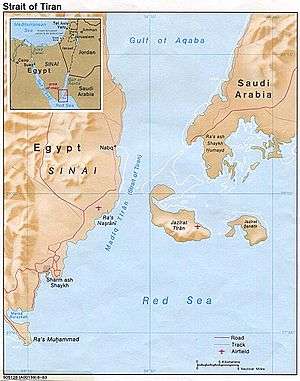Saudi–Egypt Causeway

The Saudi–Egypt Causeway is a proposal to link Egypt and Saudi Arabia with a causeway and bridge.[1]
Profile
The bridge will be called "King Salman bin Abdel Aziz Bridge".[2] The entire project is expected to cost about 4 billion US dollars and will be financed by Saudi Arabia. The causeway would link Tabuk to the Red Sea resort of Sharm el-Sheikh on the Sinai Peninsula and would pass through Tiran Island at the entrance of the Gulf of Aqaba. Funding for the causeway was announced from the Saudi Binladin Group, which will work the Egyptian government-run firm Arab Contractors.[3]
The proposed construction projects aim to create closer links between the two nations and have the potential to create plenty of jobs on both sides. This is part of a greater plan by the Egyptian government that intends to repopulate the Sinai peninsula.[4] It will also provide an alternative Hajj route, and is expected to serve a million passengers and pilgrims annually.[4]
Concerns have been raised about environment effects, and by neighbors regarding security. The extra traffic and additional development could cause a further decline of the threatened Red Sea dugong population and damage to coral reefs and fisheries.[4] One such organization, Hurghada Environmental Protection and Conservation Association (HEPCA) is fine with the bridge project moving forward, as long as an environmental survey is performed and the reefs are not harmed by the construction. Article V of the Camp David Accords between Israel and Egypt provides for the right of freedom of navigation through the Strait of Tiran.[5]
The project was suspended in 2005 by the Hosni Mubarak government, due to security concerns voiced by Israel.[6] Prior to its loss of power, the Mohamed Morsi administration was reported to be interested in finalizing plans for the project in 2012 and 2013.[7][8]
In April 2016, on a rare visit to Egypt, King Salman of Saudi Arabia announced with Egypt's President El-Sisi an agreement to build a bridge between the two countries.[9] The announcement followed Egypt and Saudi Arabia signing an agreement on maritime border demarcation and marking the islands of Tiran and Sanafir within Saudi regional waters.[10] Israel announced that it does not object to the island transfer.[11]
See also
- Transport in Saudi Arabia
- Transport in Egypt
- Bridge of the Horns - on hold, projected cost about $10b.
References
- ↑ Conrad Egbert (1 March 2008). "Tenders for $4bn Saudi-Egypt causeway this year". Arabian Business. Retrieved 31 January 2011.
- ↑ "Saudi Arabia, Egypt agree to build bridge over Red Sea". Al Jazeera. April 9, 2016.
- ↑ "Saudi Binladin Group ready to fund proposed Egypt-Saudi bridge". Ahram Online. 21 January 2013. Retrieved 6 October 2013.
- 1 2 3 Kira Walker (2 March 2013). "Egypt-Saudi bridge: Is the government sacrificing natural resources for short-term gains?". Egypt Independent. Retrieved 6 October 2013.
- ↑ "Israel hints at war with Egypt over bridge to Saudi Arabia". Middle East Monitor. 11 January 2011. Retrieved 7 October 2013.
- ↑ Volkhard Windfuhr (18 July 2011). "Crossing the Red Sea: Egypt Approves Massive Bridge to Saudi Arabia". Spiegel Online. Retrieved 6 October 2013.
- ↑ Saudi-Egypt causeway to go ahead - minister Arabian Business. 30 August 2012.
- ↑ $ 3 billion Saudi-Egypt causeway project on track Arab News. 30 August 2012. Retrieved 26 August 2014.
- ↑ "Saudi Arabia and Egypt announce Red Sea bridge". BBC News. Retrieved 2016-04-10.
- ↑ "Red Sea Tiran and Sanafir islands fall within Saudi regional waters: Egypt's cabinet - Politics - Egypt - Ahram Online". english.ahram.org.eg. Retrieved 2016-04-10.
- ↑ "Israel gives blessing to Egypt's return of Red Sea islands to Saudi Arabia". Reuters UK. Retrieved 2016-04-12.